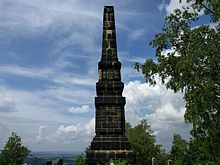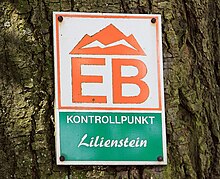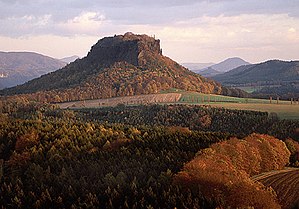Lilienstein
| Lilienstein | ||
|---|---|---|
|
Lilienstein in the evening light |
||
| height | 415.2 m | |
| location | Saxony ( Germany ) | |
| Mountains | Saxon Switzerland | |
| Coordinates | 50 ° 55 '52 " N , 14 ° 5' 5" E | |
|
|
||
| Type | Table Mountain | |
| rock | Sandstone | |
The Lilienstein is one of the most striking mountains in the Elbe Sandstone Mountains in Saxony . It is the only table mountain on the right Elbe and is the symbol of the Saxon Switzerland National Park .
Origin of the name
Its name has nothing to do with flowers, it was probably derived from St. Gilgen or St. Ilgen (earlier names were "Ylgenstein" and "Illgenstein"). This name stem can be traced back to Saint Aegidius .
Location and surroundings

The Lilienstein is located 15 kilometers east of Pirna and 5 kilometers west of Bad Schandau , in whose urban area it is located. Directly at the foot in the east is the Sellnitz estate belonging to Bad Schandau , in which the youth education center of the Saxon Switzerland National Park is housed, and in the south the small settlement Ebenheit , which belongs to the town of Königstein . Its center is on the other bank of the Elbe, where the striking Königstein Fortress is also located, the largest mountain fortress in Europe. The Elbe flows around the Lilienstein on three sides and forms a 180 ° loop here.
history


The earliest evidence of human activity on the Lilienstein Plateau is made of flint devices that were found on its southern edge. At present only a general Stone Age age between the Late Paleolithic (12,000 BC) and the Neolithic (up to 2200 BC) can be assumed. Numerous finds of Bronze Age and Iron Age ceramic shards indicate a prehistoric use, which was recently ascribed a cultic character.
The first documentary mention of the Lilienstein took place in 1379, it was called "Ylgenstein", the rock carving of a cross on the south ascent probably comes from this time. Already in the high Middle Ages (around 1200) there was a small Bohemian castle on the Lilienstein, the Lilienstein Castle . Like the Königstein, the Lilienstein also came into the possession of the Margraves of Meissen , the later dukes and electors of Saxony, in the wake of the Dohna feud around 1402 . If a castle occupation was mentioned in 1406, the castle fell into disrepair in the following decades and was probably abandoned around 1550. During excavations in 1894, the ground plans of brick fortifications were uncovered and numerous finds were recovered. In addition to the remains of the wall, there are also recesses for beams or the like on the ledges.
In 1708 August the Strong , Elector of Saxony and King of Poland, climbed the mountain and had steps built on the south side. This is reminiscent of a four-meter-high obelisk on the east side of the Lilienstein, which was destroyed by lightning on July 4, 1966 and replaced by a replica in 2008.
In 1756, the Saxon army had to surrender to the Prussian army of Frederick the Great on the flatness around the Lilienstein during the Seven Years' War . She had previously been besieged in the Pirna camp for almost two months and cut off from supplies. Troops marched around the Lilienstein in 1813 and 1866 as well, but there was no fighting. In 1865 a triangulation column was built on the Lilienstein for the Saxon land survey . On the occasion of the 800th anniversary of the Saxon ruling house of the Wettins , a 16 m high obelisk was erected as a memorial column by the Mountain Association for Saxon Switzerland in 1889 . Its shape resembles a post-mile post in Saxony .
The legend tells that after a lavish royal festival on the Königstein, the Lilienstein was given away by August the Strong to the Prussian King Friedrich Wilhelm I , but was given back by him.
tourism
In the 19th century the Lilienstein was developed for tourism and in 1873 the first small mountain inn was opened. Today there is an inn on the mountain, which is open from April to October. The Lilienstein can be climbed via two ascents. The oldest parts and steps of the south ascent date back to 1708, the north ascent was not built until 1900 by the mountain landlord Karl Friedrich Bergmann. At the beginning of the 20th century, as at the Bastei , there were plans to build a mountain railway , but these were not implemented. There is a material ropeway at Lilienstein for supply and logistics purposes for the mountain industry .
particularities
From 1989 onwards, peregrine falcons were resettled in Saxon Switzerland at Lilienstein . Previously, these birds of prey were extinct in the 1970s. A release cage was installed in the inaccessible rock walls on the east side. A total of 69 young falcons had been released there by 1996. In the Elbe Sandstone Mountains there is a stable and self-sustaining peregrine falcon population again.
In the western corner of the Lilienstein there is one of only three solid walls approved for climbing in the climbing area of Saxon Switzerland. Usually, rock climbing in Saxon Switzerland is only allowed on free-standing climbing peaks . The Lilienstein-Westecke is popular with climbers because of its long and exposed climbs. In addition, there are three “real” climbing peaks on the Lilienstein with the Liliensteinnadel , Liliensteinwächter and Heini .
At the foot of the Lilienstein, in a forest cemetery on Sellnitzgrund, 117 dead, displaced persons from Bohemia, mainly old people and babies who died in a barrack camp at this point, were buried between 1945 and 1947.
Paths to the summit

- A possible starting point for an ascent is the city of Königstein. From there, the path from the ferry with blue signposts leads over the south ascent to the summit.
- Other possible starting points are Rathen , Waltersdorf and Prossen.
- The blue- marked long-distance hiking trails Zittau - Wernigerode , Eisenach-Budapest (EB) and the European long-distance hiking trail E3 lead over the mountain .
gallery
Lilienstein from Königstein Fortress
View from the Papststein to Gohrisch , Königstein , Lilienstein and Gohrisch health resort
(from left to right)
See also
Individual evidence
- ↑ M. Torke: On prehistoric finds from the Hockstein cave (Wolfshöhle / RA-16) near Hohnstein / Saxon Switzerland . In: The cave explorer . 35, 2003, p. 98.
- ↑ K. Simon, M. Torke: The French Cave (5050 / KÖ-44), a prehistoric cult place on Lilienstein / Saxon Switzerland . In: The cave explorer . Dresden vol. 39, issue 3, 2007, pp. 68–96.
- ^ W. Coblenz: On the earliest settlement of the Lilienstein in Saxon Switzerland . In: excavations and finds . 12/1967, pp. 83-86.
literature
- Alfred Meiche : Historical-topographical description of the Pirna administration . Dresden 1927.
- Peter Rölke (ed.): Hiking and nature guide Saxon Switzerland , Volume 2, Berg- und Naturverlag Rölke, Dresden 2013.












